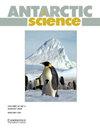Four unreported emperor penguin colonies discovered by satellite
IF 2
4区 地球科学
Q3 ENVIRONMENTAL SCIENCES
引用次数: 0
Abstract
Predictions of the future emperor penguins population, linked to anthropogenic climate change, are stark. Current models suggest that if CO卫星发现四个未报告的帝企鹅群落
对未来帝企鹅数量的预测与人为气候变化密切相关。目前的模型显示,如果二氧化碳排放量继续以目前的速度上升,到本世纪末,几乎所有的企鹅群都将接近灭绝(Jenouvrier et al.2021)。监测种群对于跟踪这些变化以及在可能的情况下实施保护措施至关重要。最近利用卫星图像发现、跟踪和监测帝企鹅种群的工作已证明是了解该物种的位置、数量和趋势的关键技术(Barbraud & Weimerskirch 2001, Trathan et al.2020, Jenouvrier et al.2021)。它还能发现未记录的繁殖地(Fretwell 等人,2009 年),尽管确定什么是新的或未发现的繁殖地存在固有的困难(见补充材料 S1)。2019年,利用欧洲航天局的哨兵-2号卫星(空间分辨率为每像素10米的中分辨率卫星)发现了8个以前未报告的帝企鹅繁殖地(Fretwell & Trathan 2021),从而使已知的现存繁殖地数量达到61个。 在此,我报告了利用哨兵-2号卫星和Maxar WorldView-2图像发现的另外4个繁殖地。
本文章由计算机程序翻译,如有差异,请以英文原文为准。
求助全文
约1分钟内获得全文
求助全文
来源期刊

Antarctic Science
地学-地球科学综合
CiteScore
3.60
自引率
6.20%
发文量
42
审稿时长
3 months
期刊介绍:
Antarctic Science provides a truly international forum for the broad spread of studies that increasingly characterise scientific research in the Antarctic. Whilst emphasising interdisciplinary work, the journal publishes papers from environmental management to biodiversity, from volcanoes to icebergs, and from oceanography to the upper atmosphere. No other journal covers such a wide range of Antarctic scientific studies. The journal attracts papers from all countries currently undertaking Antarctic research. It publishes both review and data papers with no limits on length, two-page short notes on technical developments and recent discoveries, and book reviews. These, together with an editorial discussing broader aspects of science, provide a rich and varied mixture of items to interest researchers in all areas of science. There are no page charges, or charges for colour, to authors publishing in the Journal. One issue each year is normally devoted to a specific theme or papers from a major meeting.
 求助内容:
求助内容: 应助结果提醒方式:
应助结果提醒方式:


